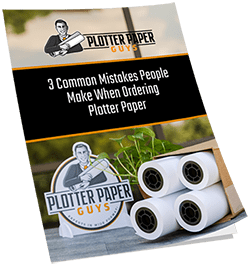You are responsible for designing a poster for a business presentation. Before you begin choosing your text and graphics, you think, “What is the standard size for a poster?” Well, there is no single standard size for posters that are universally used.
Some of the standardized poster sizes will work best for the readability you need for a presentation. If you keep reading, you’ll find out the best size to win over your audience.
What is the Standard Size for a Poster?
There are actually four most common sizes for posters in North America: 11″ x 17″, 18” x 24”, 24” x 36”, and 27” x 40”. A paper size system determined these types of posters.
Most paper producers and printing companies, such as Plotter Paper Guys, should have these standard poster paper sizes in stock. The poster size you choose to showcase your designs or information depends on how many posters you need, your budget, and what your purpose is.
Primary Series of Poster Sizes
Standards of poster paper sizes have existed since the 20th century. There are three main paper standards to know: ANSI, ARCH series, and ISO 216 A series. The distribution of the standard series is largely defined by the global division of the imperial and metric measurement systems.
What is ISO 216?
ISO 216 (International Standards Organization) is an international standard for paper sizes used globally, except in the United States, Canada, and parts of Latin America. The metric system influenced the ISO paper sizes. The paper size system contains an A Series format, B Series format, and C series format.
North American ANSI Poster Sizes
In North America, the (American National Standards Institute) ANSI series (A, B, C, D, E) is based on the standard ANSI A or letter size of 8.5″ x 11″.
Letter-sized posters are often used for flyers or seen displayed on community bulletin boards, information desks, art galleries, and street posts. Other paper sizes include legal (8.5″ × 14″), executive (7″ x 10″),and ledger/tabloid (11″ × 17″). Additionally, the standard measure of a printed business card is 3.5″ x 2″.
In 1995, a subset called ARCH was developed based upon revisions to the ANSI standard. ARCH poster sizes were designed for architectural purposes like designing blueprints and primarily have aspect ratios of 4:3 or 3:2. Such aspect ratios are comparable to the aspect ratio used for computer screens.
Standard Movie Poster Sizes
Movie poster sizes in America are usually sheets that measure 27″ x 40,” or roughly 69 cm × 102 cm. One sheet summarizes the movie for advertisement.
Before the mid-1980s, sheets measured 27″ x 41″. You can date a poster by its size. If it is 27″ x 41″, it was printed before 1985.
Another size that the entertainment industry has standardized is the bus stop, or subway poster, which is typically 40″ x 60″, or about 102 cm x 153 cm.
Official movie promotions only use these poster dimensions. Retailers may sell movie posters that are smaller or larger, but they are not authentic.
What size is 24″ x 36″ in a poster?
Posters that are 24” x 36”, or approximately 61 x 91 cm, are often used for product advertising, wall decoration, event promotion, menus, and news announcements. These posters are also great for trade shows and anywhere with a lot of foot traffic because they are visible from a distance. Depending on the design of the poster, it may be viewed from 10 yards away.
The key to designing this large 24 x 36 standard size is to put the main message in large, bold text. Additionally, any graphic works well with the dimensions, including photos, illustrations, bold text, minimal designs, or intricate designs.
Large, ARCH D, or Super A1 are other names for the 24” x 36” poster size. American architects often use this poster size as well as ARCH C, which is 18″ x 24″ or 46 cm x 61 cm, for printing blueprints. Additionally, ARCH C and D are commonly used poster sizes for presenting documents or drawings to a group or displaying on a wall
How big is an 18″ x 24″ poster?
In addition to architectural purposes, the standard 18″ ×24″ medium-sized posters are popular for decorating on bulletin boards as well as walls because they fit into regular poster framing.
They are also large enough for photography, artwork, informational signs, and advertisement and promotions of concerts, festivals, or sporting events.
The best way to mail an 18″ ×24″ poster is to roll it into a tube.
Industry Standard Poster Size
Small posters that measure 11″ x 17″ may be referred to as A3, Ledger, Tabloid, or ANSI B sizes. This poster size is widely available and is usually about the largest a standard office copier will print. You can conveniently mail an 11″ × 17″ poster without rolling or folding it. Most post offices offer the appropriate envelopes and carriers have standard rates for mailing envelopes with these dimensions. The small poster is popular for personal decoration or commercial advertisements in public buildings, on bulletin boards, or as handouts because they are easily portable. For visually appealing designs on this size of poster, you should choose bold typography, minimalist illustrations, lots of negative space, and a simple color palette.
Where Can You Buy Poster Products?
Plotter Paper Guys offers products ranging from Diazo Papers, Engineering Copier Papers, Backlit and Banner Media, to Kraft Paper and Well Log Media. Businesses and architects in need of plotter paper can find products in various sizes from sheets to 500-foot rolls.
Custom Sizing to Meet Your Poster Needs
Hopefully, this has helped answer questions people ask, such as “What is the standard size for a poster?” You have many options that could fulfill your design aspirations, such as the large 24” x 36”, medium 18” x 24”, small 11” x 17”, and the U.S. letter size 8.5” x 11”.
Plotter Paper Guys provides sheets of these standard poster sizes as well as custom sizing. With a professional company like Plotter Paper Guys, you can play with customized dimensions when designing a poster. We encourage you to complete an online form about your specific needs and a Plotter Paper Guys representative will contact you about your request.




